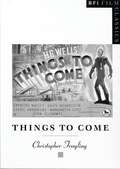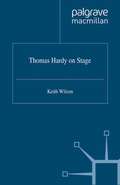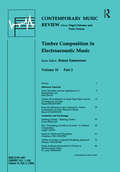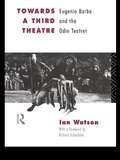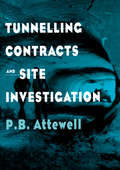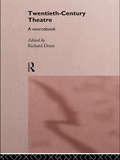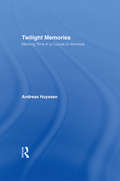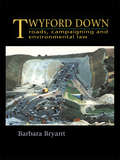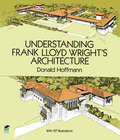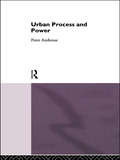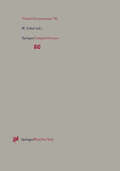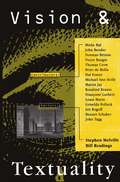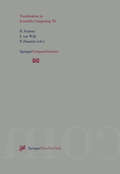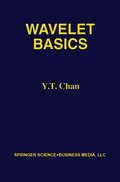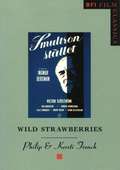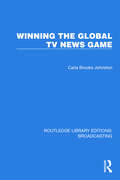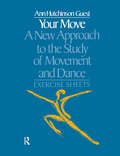- Table View
- List View
Things to Come (BFI Film Classics)
by Christopher FraylingThe release of 'Things to Come' in 1936 was one of the key moments in the history of science fiction in the cinema. The film was the brainchild of H. G. Wells, whose worldwide reputation as a thinker had persuaded its producer, Alexander Korda, to offer him a contract giving him virtually total control over the project. Korda drafted a dazzling array of talents to render into pictures Wells's ideas of the future a hundred years hence. His brother, Vincent Korda, a distinguished painter, was employed as art director, and the Bauhaus artist Laszlo Moholy-Nagy contributed ideas for futuristic sets. As director, Korda hired William Cameron Menzies, who had practically invented the profession of Hollywood art director through his work with Douglas Fairbanks on 'The Thief of Baghdad 'and Rudolf Valentino on 'Son of the Sheik,' and whose career would climax with 'Gone With the WInd.' The result was a landmark in cinematic design. Christopher Frayling shows, with a wealth of illustrations, how the boldness and brilliance of the sets and costumes mark out 'Things to Come 'as British cinema's greatest contribution to the science fiction genre, amply justifying his judgement that ''Things to Come 'is to modernism as 'Blade Runner' is to postmodernism.'
Thomas Hardy on Stage
by K. Wilson'Meticulously researched and lucidly written, this volume will likely become and remain the definitive study of the history of works Hardy adapted for the stage and of the Hardy Players who, in the main, performed them.' - John J. Conlon, English Literature in Transition 'Much new research informs this first full-length study of Hardy's involvement in stage productions based on his own works. The result is a closely reasoned account of the conflict between his desire to see his plots and characters brought to the stage, and his awareness of the attending difficulties.' - M.S. Vogeler, Choice Despite Hardy's lifelong interest in the theatre, this is the first comprehensive study of all aspects of his involvement with the stage, the only area of his literary activities left substantially unexplored. It discusses his own experiments at crafting scenarios and plays, all productions, both amateur and professional, with which he had any involvement, and his troubled negotiations with adapters, producers, and actors. It is fascinating for what it reveals about both the artist and the man, and offers particular insight into the paradoxical connections between the retiring Dorchester celebrity and the international man of letters.
Timbre Composition in Electroacoustic Music (Contemporary Music Review)
by Simon EmmersonFirst Published in 1994. The contributions to this collection have been selected to define a range of interests from the technical, aesthetic, cognitive and compositional spheres. The book addresses the continuing need for musicologists, psychologists, composers and listeners to enter into a creative dialogue with designers and builders, who are usually programmers in the contemporary world. The collection as a whole will help to demonstrate the great potential for exchange between the multidisciplinary approaches to music.
Timbre Composition in Electroacoustic Music (Contemporary Music Review #10.2)
by Simon EmmersonFirst Published in 1994. The contributions to this collection have been selected to define a range of interests from the technical, aesthetic, cognitive and compositional spheres. The book addresses the continuing need for musicologists, psychologists, composers and listeners to enter into a creative dialogue with designers and builders, who are usually programmers in the contemporary world. The collection as a whole will help to demonstrate the great potential for exchange between the multidisciplinary approaches to music.
Towards a Third Theatre: Eugenio Barba and the Odin Teatret
by Ian WatsonEugenio Barba is one of Europe's leading theatre directors, at the forefront of experimental and group theatre for more than twenty years. Ian Watson provides the most comprehensive and systematic study of Barba's work, including his training methods, dramaturgy, productions and theories, as well as his work at the International School of Theatre Anthropology.
Towards a Third Theatre: Eugenio Barba and the Odin Teatret
by Ian WatsonEugenio Barba is one of Europe's leading theatre directors, at the forefront of experimental and group theatre for more than twenty years. Ian Watson provides the most comprehensive and systematic study of Barba's work, including his training methods, dramaturgy, productions and theories, as well as his work at the International School of Theatre Anthropology.
A Tree of Life: Diversity, Flexibility and Creativity in Jewish Law [Second Edition] (The Littman Library of Jewish Civilization)
by Louis JacobsThis study of the Jewish legal system (the Halakhah) demonstrates that the law embraces every corner of life.
Tunnelling Contracts and Site Investigation
by Dr P.B. AttewellA wide ranging and up-to-date review of experience of tunnelling contracts, particularly those for sewerage and drainage tunnels. The review is based on the 6th edition of the ICE Conditions of Contract, but it takes note of new forms of contract which are leading towards less adversarial contractual relations.^
Twentieth Century Theatre: A Sourcebook
by Richard DrainTwentieth Century Theatre: A Sourcebook is an inspired handbook of ideas and arguments on theatre. Richard Drain gathers together a uniquely wide-ranging selection of original writings on theatre by its most creative practitioners - directors, playwrights, performers and designers, from Jarry to Grotowski and Craig. These key texts span the twentieth century, from the onset of modernism to the present, providing direct access to the thinking behind much of the most stimulating theatre the century has had to offer, as well as guidelines to its present most adventurous developments. Setting theory beside practice, these writings bring alive a number of vital and continuing concerns, each of which is given full scope in five sections which explore the Modernist, Political, Inner and Global dimensions of twentieth century theatre. Twentieth Century Theatre: A Sourcebook provides illuminationg perspectives on past history, and throws fresh light on the sources and development of theatre today. This sourcebook is not only an essential and versatile collection for students at all levels, but also directed numerous devised shows which have toured to theatres, schools, community centres and prisons.
Twentieth Century Theatre: A Sourcebook
by Richard DrainTwentieth Century Theatre: A Sourcebook is an inspired handbook of ideas and arguments on theatre. Richard Drain gathers together a uniquely wide-ranging selection of original writings on theatre by its most creative practitioners - directors, playwrights, performers and designers, from Jarry to Grotowski and Craig. These key texts span the twentieth century, from the onset of modernism to the present, providing direct access to the thinking behind much of the most stimulating theatre the century has had to offer, as well as guidelines to its present most adventurous developments. Setting theory beside practice, these writings bring alive a number of vital and continuing concerns, each of which is given full scope in five sections which explore the Modernist, Political, Inner and Global dimensions of twentieth century theatre. Twentieth Century Theatre: A Sourcebook provides illuminationg perspectives on past history, and throws fresh light on the sources and development of theatre today. This sourcebook is not only an essential and versatile collection for students at all levels, but also directed numerous devised shows which have toured to theatres, schools, community centres and prisons.
Twilight Memories: Marking Time in a Culture of Amnesia
by Andreas HuyssenIn this new collection of essays on memory and amnesia in the postmodern world, cultural critic Andreas Huyssen considers how nationalism, literature, art, politics, and the media are obsessed with the past. The great paradox of our fin-de-siecle culture is that novelty is even more associated with memory than with future expectation. Drawing heavily on the dilemmas of contemporary Germany, Huyssen's discussion of cultural memory illustrates the nature of contemporary nationalism, the work of such artists and thinkers as Anselm Kiefer, Alexander Kluge, and Jean Baudrillard, and many others. The book includes illustrations from contemporary Germany.
Twilight Memories: Marking Time in a Culture of Amnesia
by Andreas HuyssenIn this new collection of essays on memory and amnesia in the postmodern world, cultural critic Andreas Huyssen considers how nationalism, literature, art, politics, and the media are obsessed with the past. The great paradox of our fin-de-siecle culture is that novelty is even more associated with memory than with future expectation. Drawing heavily on the dilemmas of contemporary Germany, Huyssen's discussion of cultural memory illustrates the nature of contemporary nationalism, the work of such artists and thinkers as Anselm Kiefer, Alexander Kluge, and Jean Baudrillard, and many others. The book includes illustrations from contemporary Germany.
Twyford Down: Roads, campaigning and environmental law
by Barbara BryantThe Twyford Down story is set in a political and historical framework in order to examine the key issues affecting road planning and environmental protection: the system of route selection; Crown development; government agents, NGOs and locally elected authorities; conservation legislation; subsidiarity; lobbying techniques; and the role of the press. Written in a lively style and vividly illustrated, Twyford Down will appeal to environmental advisors, policy makers and planners as well as lobbyists and those interested in the environment.
Twyford Down: Roads, campaigning and environmental law
by Barbara BryantThe Twyford Down story is set in a political and historical framework in order to examine the key issues affecting road planning and environmental protection: the system of route selection; Crown development; government agents, NGOs and locally elected authorities; conservation legislation; subsidiarity; lobbying techniques; and the role of the press. Written in a lively style and vividly illustrated, Twyford Down will appeal to environmental advisors, policy makers and planners as well as lobbyists and those interested in the environment.
Understanding Frank Lloyd Wright's Architecture
by Donald Hoffmann"May be the best book on Wright ever written, with the exception of the master's own incomparable autobiography." — New York Times Book ReviewDespite the vast literature about Frank Lloyd Wright, noted Wright scholar Donald Hoffmann contends that observations about Wright commonly fail to reach any understanding of his art and few commentaries deal with the principles of his architecture. What inspired his work? How did his architecture mature? What are the dynamics of its characteristic expression? Why will the formative principles always be valid?The answers to these and other questions about Wright's architectural philosophy, ideals and methods can be found in this superb treatment, enhanced with 127 photos, plans, and illustrations of a host of Wright masterworks. Among these are the Robie house, the Winslow house, Fallingwater, Hollyhock House, the Larkin Building, Unity Temple, Taliesin, the Guggenheim Museum, the Johnson Wax Building, and many more.Expertly analyzing Wright's approach to siting, furnishing, landscaping, and other details, Mr. Hoffmann has written an insightful guide to the concepts that gave Wright's architecture "not only its extraordinary vigor of structure and form, expression and meaning, but its surprising continuity." The book will be essential reading for all Wright fans and anyone interested in the evolution of modern architecture.
Urban Process and Power
by Peter AmbroseUrban Process and Power has two chief aims. Firstly, it analyses and explains a century of the production and reproduction of the urban environment in which most of us live. Secondly, the book focuses on recent changes in the control of these processes and the ideology that has brought these changes about. Immense disparities exist between the "best" and the "worst" urban areas in Britain. Why do these differences arise and how are they perpetuated? The author argues that the growth of such inequality is linked to questions of accountability and the increasing erosion of a democratic principle in the urban process.
Urban Process and Power
by Peter AmbroseUrban Process and Power has two chief aims. Firstly, it analyses and explains a century of the production and reproduction of the urban environment in which most of us live. Secondly, the book focuses on recent changes in the control of these processes and the ideology that has brought these changes about. Immense disparities exist between the "best" and the "worst" urban areas in Britain. Why do these differences arise and how are they perpetuated? The author argues that the growth of such inequality is linked to questions of accountability and the increasing erosion of a democratic principle in the urban process.
Virtual Environments ’95: Selected papers of the Eurographics Workshops in Barcelona, Spain, 1993, and Monte Carlo, Monaco, 1995 (Eurographics)
by Martin GöbelVirtual Environments -(VE) the new dimension in man-machine-communication -have been developed and experienced in Europe since 1990. In early 1993 the Eurographics Association decided to establish a working group on Virtual Environments with the aim to communicate advances in this fascinating area on a scientific and technical level. In September 1993 the first workshop on VEs was held in Barcelona, Spain, in conjunction with the annual Eurographics conference. The workshop brought together about 35 researchers from Europe and the US. The second workshop was held together with Imagina '95 in Monte Carlo, Monaco. This time, around 40 researchers from Europe, the US, but also from Asia met for a 2-day exchange of experience. Needless to say -as in all Eurographics workshops -we found the atmosphere very open and refreshing. The workshops were sponsored by ONR (Office of Naval Research), UK; US Army Research Institute, UK; University of Catalonia, Spain; EDF France; CAE France, INA France and IGD Germany and locally organized by Daniele Tost and Jaques David. While in the first workshop in 1993 many concepts in VE were presented, the '95 workshop showed up various applications in different areas and demonstrated quite clearly that Virtual Environments are now used in interactive applications.
Vision and Textuality
This volume brings together the work of distinguished critics and art historians in order to reflect and assess the impact of current critical theory on the discipline and practice of art history. Centring on the intersection of questions of vision with the problematic of textuality, the book addresses how issues of politics, semiotics, psychoanalysis and historiography have contributed to the emergent terms and practices of the new art histories.
Visualization in Scientific Computing ’95: Proceedings of the Eurographics Workshop in Chia, Italy, May 3–5, 1995 (Eurographics)
by Riccardo Scateni Jarke J. Van Wijk Pietro ZanariniVisualization is nowadays indispensable to get insight into the huge amounts of data pro duced by large scale simulations or advanced measurement devices. The use of com puter graphics for scientific purposes has become a well established discipline, known as Scientific Visualization. Many problems still have to be solved, and hence the field is a very active area for research and development. This book represents results of the sixth in a well established series of international workshops on Visualization in Scien tific Computing organized by the EUROGRAPHICS Association in collaboration with CRS4 (Center for Advanced Studies, Research and Development in Sardinia), held from May 3 to May 5,1995, in Chia, Italy. The thirteen contributions selected for this volume cover a wide range of topics, ranging from detailed algorithmic studies to searches for new metaphors. A rough di vision can be made into the parts interaction, irregular meshes, volume rendering, and applications. Interaction in three dimensions is a challenging area for research. The use of three dimensional user interfaces for more natural manipulation of three-dimensional data and their visualization is natural, but is far from trivial to realize. Pang et al. investigate the use of common objects such as spray cans and carving knives as metaphors for visualiza tion tools, in order to provide an intuitive and natural three dimensional user interface. Gibson uses a voxel-based data representation, not only for visualization, but also for physical modeling of objects. A prototype system under development for haptic explo ration is discussed.
Wavelet Basics
by Y. T. ChanSince the study of wavelets is a relatively new area, much of the research coming from mathematicians, most of the literature uses terminology, concepts and proofs that may, at times, be difficult and intimidating for the engineer. Wavelet Basics has therefore been written as an introductory book for scientists and engineers. The mathematical presentation has been kept simple, the concepts being presented in elaborate detail in a terminology that engineers will find familiar. Difficult ideas are illustrated with examples which will also aid in the development of an intuitive insight. Chapter 1 reviews the basics of signal transformation and discusses the concepts of duals and frames. Chapter 2 introduces the wavelet transform, contrasts it with the short-time Fourier transform and clarifies the names of the different types of wavelet transforms. Chapter 3 links multiresolution analysis, orthonormal wavelets and the design of digital filters. Chapter 4 gives a tour d'horizon of topics of current interest: wavelet packets and discrete time wavelet transforms, and concludes with applications in signal processing.
Wild Strawberries (BFI Film Classics)
by Philip French Kersti FrenchWild Strawberries (1958) is probably Ingmar Bergman's most personal film and one which explores his relation to the history of Swedish cinema. Philip and Kersti French give a detailed account of Bergman's powerful and intense direction of the film. They set the film firmly in the context of Swedish life and culture. The authors also trace connections with the plays of August Strindberg, and the paintings of Edvard Munch and Carl Larsson.
Winning the Global TV News Game (Routledge Library Editions: Broadcasting #39)
by Johnston Carla BrooksWinning the Global TV News Game (1995) examines the worldwide TV news revolution of the 1990s, dealing with live TV news as an industry–consumer relationship. It’s a marketing approach – focusing on regional markets across the globe, looking at industry players and the hardware they had put in place. Much of this analysis is told by leading news media professionals who describe the latest thinking and newest developments in their own words.
Winning the Global TV News Game (Routledge Library Editions: Broadcasting #39)
by Johnston Carla BrooksWinning the Global TV News Game (1995) examines the worldwide TV news revolution of the 1990s, dealing with live TV news as an industry–consumer relationship. It’s a marketing approach – focusing on regional markets across the globe, looking at industry players and the hardware they had put in place. Much of this analysis is told by leading news media professionals who describe the latest thinking and newest developments in their own words.
Your Move: Exercise Sheets
by Ann Hutchinson GuestFirst published in 1995. A collection of sixty exercise sheets for activities in dance that include such areas as shifting body areas, body direction like tilting, displacement, and destination motion as well as contraction, elongation, folding, rotational twists, and the five forms of aerial steps.
